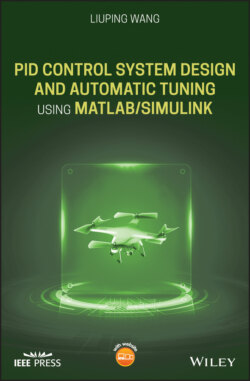Читать книгу PID Control System Design and Automatic Tuning using MATLAB/Simulink - Liuping Wang - Страница 32
1.4.1 IMC-PID Controller Tuning Rules
ОглавлениеThe internal model control (IMC)-PID tuning rules (Rivera et al. (1986)) are proposed on the basis of a first order plus delay model:
When using the IMC-PID tuning rules, a desired closed-loop response is specified by the transfer function from the reference signal to the output:
where is the desired time constant chosen by the user. The PI controller parameters are related to the first order plus delay model and the desired closed-loop time constant , which are given as:
(1.46)
If the system has a second order transfer function with time delay in the following form:
then a PID controller is recommended. Assuming that , then the PID controller parameters are calculated as
Later on, it was realized that the choice of basically led to a pole-zero cancellation in the control system. Such a pole-zero cancellation will limit, as discussed in the next chapter, the control system performance in the disturbance rejection, particularly when is large4. In Skogestad (2003), the IMC-PID tuning rules are modified to reduce the integral time constant as
(1.48)
while and are unchanged from (1.47).
The IMC-PID controller tuning rules are also extended to integrating systems in Skogestad (2003). Although the system has an integrator as part of its dynamics, integral control is still required for disturbance rejection (see Chapter 2).
Assuming that the system has the integrator with delay model:
(1.49)
then a PI controller is recommended with the following parameters:
(1.50)
If the transfer function for the integrating system has the form:
(1.51)
then a PID controller is recommended to have the following parameters:
(1.52)
If the system has a double integrator with the transfer function
(1.53)
then a PID controller is recommended with the following parameters:
(1.54)
The IMC-PID controller tuning rules will be studied in Examples 2.1 and 2.2.
